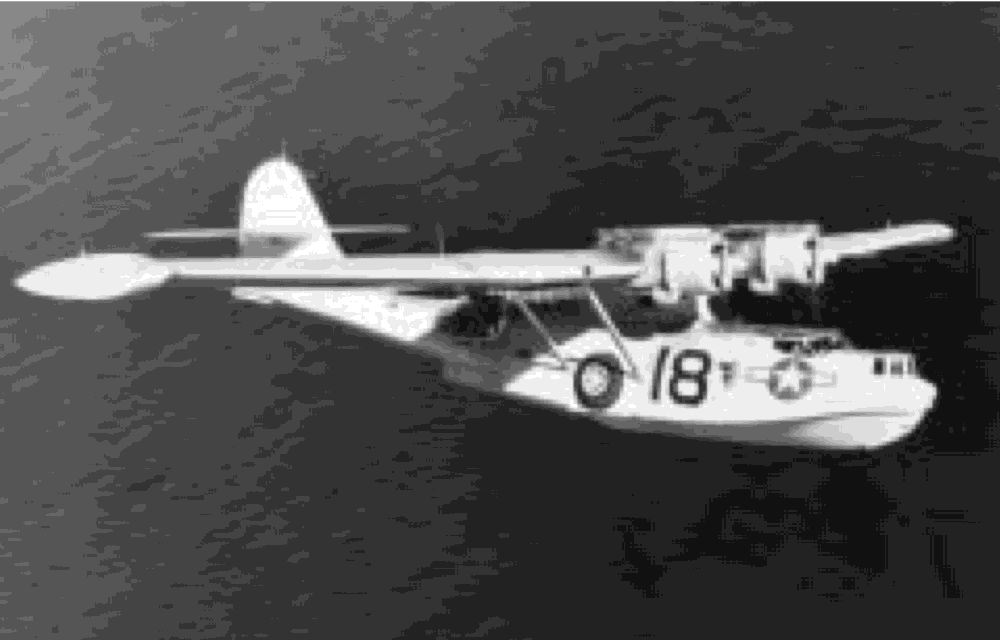
118
UNITED STATES NAVAL AVIATION
1910-1995
1942-Contin ued
3 July
In the first successful firing of an American
rocket from a plane in flight, Lieutenant Commander
James H. Hean, Gunnery Officer of Transition Training
Squadron, Pacific Fleet, fired a retro-rocket from a
PBY-5A in flight at Goldstone Lake, Calif. The rocket,
designed to be fired aft with a velocity equal to the
forward velocity of the airplane, and thus to fall verti-
PBY-5A, amphibious version of the Catalina f7ying boat, carnes
retro-rockets for antisubmwjne warfare 700504
cally, was designed at the California Institute of
Technology. Following successful tests, the retro-rock-
et became a weapon complementary to the magnetic
airborne detector with Patrol Squadron 63 receiving
the first service installation in February 1943.
7 July
An agreement was reached between the Army
and Navy, which provided that the Army would deliv-
er to the Navy a specified number of B-24 Liberators,
B-25 Mitchells, and B-34 Venturas to meet the Navy's
requirement for long range landplanes. Also, the Navy
would relinquish its production cognizance of the
Boeing Renton plant to the Army for expanded B-29
production and limit its orders for PBYs to avoid inter-
ference with B-24 production.
12 July
Patrol Wings were reorganized to increase
the mobility and flexibility of patrol aviation.
Headquarters Squadrons were authorized for each
wing to furnish administrative and maintenance ser-
vices to attached squadrons. Geographic areas of
responsibility were assigned to each wing, and perma-
nent assignment of squadrons was abolished in favor
of assignment as the situation required.
19 July
The seaplane tender
Casco
established an
advanced base in Nazan Bay, Atka, Aleutian Islands, to
support seaplane operations against Kiska, which
included antishipping search, bombing of enemy posi-
tions, and cover for surface force bombardments.
24 July
The Bureau of Aeronautics issued a Planning
Directive calling for procurement of four Sikorsky heli-
copters for study and development by Navy and Coast
Guard aviation forces.
1 August
A J4F Widgeon, piloted by Ensign Henry
C. White of Coast Guard Squadron 212, based at
Houma, La., scored the first Coast Guard kill of an
enemy submarine with the sinking of the German U-
166 off the passes of the Mississippi.
7 August
Marine Aircraft Wings, Pacific was orga-
nized at San Diego, Calif., under command of Major
General Ross E. Rowell for the administrative control
and logistic support of Marine Corps aviation units
assigned to the Pacific Fleet. In September 1944, this
command was renamed Aircraft, Fleet Marine Force,
Pacific.
7 August
1942-9
February
1943
Capture of
Guadalcanal-Air support for the U.S. Marines' first
amphibious landing of World War II was provided by
three carriers of Air Support Force (Rear Admiral Leigh
Noyes), and by Navy, Marine, and Army units of
Aircraft, South Pacific (Rear Admiral John S. McCain)
operating from bases on New Caledonia and in the
New Hebrides. Carrier forces withdrew from direct
support (9 Aug) but remained in the area to give over-
all support to the campaign during which they partici-
pated in several of the naval engagements fought over
the island.
Saratoga
sank the Japanese light carrier
Ryujo
in the Battle of the Eastern Solomons (23-25
Aug);
Enterprise
was hit by carrier-based bombers (24
Aug) and forced to retire;
Saratoga
was damaged by a
submarine torpedo (31 Aug) and forced to retire; and
Wasp
was sunk by a submarine (15 Sep) while escort-
ing a troop convoy to Guadalcanal.
Hornet,
in Task
Group 17 (Rear Admiral George D. Murray), hit targets
in the Buin- Tonolei-Faisi area (5 Oct); attacked
beached Japanese transports and supply dumps on
Guadalcanal; destroyed a concentration of seaplanes
at Rekata Bay (16 Oct); and, with
Enterprise,
fought in
the Battle of Santa Cruz (26-27 Oct) in which she was
sunk by air attack. In final carrier actions of the cam-
paign,
Enterprise
took part in the last stages of the
Naval Battle for Guadalcanal (12-15 Nov), assisting in
sinking 89,000 tons of war and cargo ships, and in the
Battle of Rennel Island (29-30 Jan) in which two
escort carriers also participated. Ashore, air forces in
great variety provided direct support. Navy patrol
squadrons flew search, rescue, and offensive missions
from sheltered coves and harbors. Marine Fighter
 |
18 |
 |